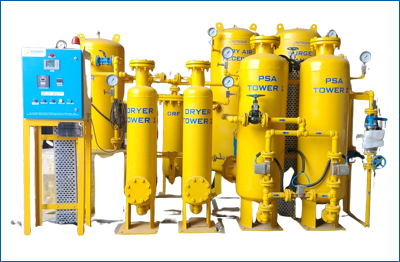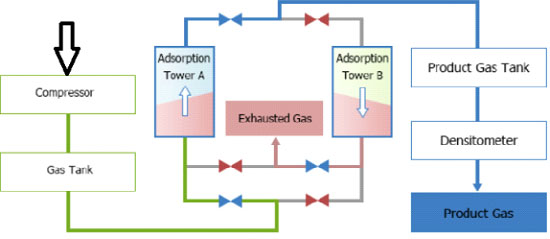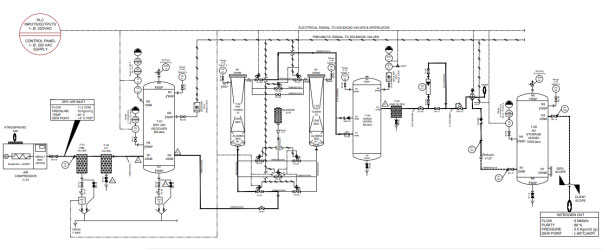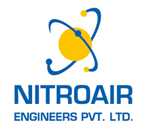Call Anytime
-
-
Send Email
sales@nitroairengineers.com
PSA Nitrogen Plant

Pressure swing adsorption or PSA is a process that separates single gases from a gas mixture. PSA is a non-cryogenic air separation process that is commonly used.
The air gas adsorbed by Carbon Molecular Sieve depends on temperature, gas pressure, gas composition, and adsorption velocity. Pressure Swing Adsorption makes use of cyclic pressurization and depressurization steps, where more gas is adsorbed at high pressure and then released when the pressure is reduced. PSA does not require heat energy, and the desorption-adsorption conditions can be adjusted by switching pressurization and depressurization. Thus enables PSA to operate at a short cycle time. The figure below illustrates a typical PSA system. Pressured raw gas is directed to A, one of two adsorption vessels packed with CMS. Under high pressure, while preferentially adsorbed gas constituents remain in the CMS bed, other constituents pass through the vessel to produce purified product gas. When the vessel A has reached its adsorption capacity, the raw gas is directed to vessel B and vessel A is depressurized. Adsorbed elements are thus released and the CMS is ready for another cycle. The cycling between the two vessels enables the continuous production of purified gas.

Benefits of Producing Own N2
Standard Features
- You save money – N2 from the Generator costs 30% to 50% of N2 from a cylinder. Payback periods are generally less than one year, which can reduce further if you have compressed air already available in your manufacturing facility.
- It gives N2 of better and more consistent purity than that available from cylinders where O2 content can vary from 0.5% to 4% (based on actual measurements taken by us). In our Generator, continuous online O2 measurement is available.
- Elimination of risk of accidents that may take place due to handling of N2 cylinders as well as due to excess O2 in cylinders.
Difference illustrates
| Nitrogen Generator |
|
Nitrogen Cylinder |
N2 Generator gas costs only Rs. 5 -7 /- Per Nm3 for commercial use |
ECONOMY |
N2 Cylinders gas costs Rs. 20-32 /-Per Nm3 for commercial use |
No hidden costs with Nitrogen generators |
HIDDEN COST |
Many hidden costs e.g. Cylinder gas price,Cylinder demurrage, labour cost to change cylinder |
Gets continuous and reliable N2 supply round the clock & thus production never suffers due to want of N2 gas |
RELIABILITY |
Dependency on the availability of the cylinders all the times |
N2 Purity is very steady and reliable |
SAFETY |
N2 Purity is never reliable and varies from cylinder to cylinder |
Advantages
- Fully Automatic System less manpower requirement.
- Simplified system for easy maintenance.
- Allowing you to privately generate nitrogen gas with cost reduction.
Application
Processing and storing perishable foods and BeveragesWhen nitrogen is used in a package, it drives out oxygen and any moisture present. By modifying the atmosphere inside the package, food packaging with nitrogen preserves quality, slows down spoilage, and extends the products' shelf life In oldest methods of preservation are drying, refrigeration, and fermentation. Modern methods include canning, pasteurization, freezing, irradiation, and the addition of chemicals. Advances in packaging materials have played an important role in modern food preservation In soft drinks, sparkling water, beer, wine, juice drinks, tea, flavored water, sports drinks and many other carbonated and non-carbonated beverages, nitrogen provides unique functionality to reduce foaming, protect flavors, retain desired colors, and maintain the integrity of your product

Heat treatment of Metals
Nitrogen, being an inert gas, is used to provide an inert atmosphere within the furnace during the heating and cooling process. Because oxygen blasting is used in furnaces, it creates oxidation and chemical reactions which makes nitrogen a key gas to neutralize the environment
Processing plastic and fibersNitrogen gas is a key component of successful plastic manufacturing. Through various methods, nitrogen gas helps to prevent discoloration and oxidation during the manufacturing process. Additionally, it helps the plastic polymer stay strong, which is especially important when large molds are being used
For Microchip productionNitrogen is used widely in many processes to provide an inert environment or to purge reactive gases after the completion of a process. Oxygen is used for the oxidation of silicon, one of the most critical processes in all of semiconductor manufacturing.
Preclusion of oxidation of chemicalsNitrogen is commonly used during sample preparation in chemical analysis. It is used to concentrate and reduce the volume of liquid samples. It is used in the production of fertilizers, nitric acid, nylon, dyes, and explosives.
Preclusion of explosions and reactions in chemical plantsNitrogen gas is used to displace oxygen and prevent explosions in highly dangerous atmospheres, such as chemical plants and manufacturing facilities With inertization, nitrogen displaces the oxygen in the atmosphere to such low levels that it prevents an eruption. Since nitrogen is inert and does not support combustion, it is safely used to displace flammable liquids and explosive mixtures.
Pipeline cleaningNitrogen is used to displace hydrocarbons in a pipeline or push a “pig” down a pipeline during cleaning operations. Nitrogen is also used to dry chemical pipelines to very low dew points, or for general inerting during plant turnarounds.It provides nitrogen purging, commonly used to displace hazardous gases or dry residual fluids within a pipeline, often in conjunction with pipeline cleaning or hydrostatic testing. Nitrogen’s dry, inert properties allow it to safely displace gas and absorb fluids without risk of fire or explosion. Nitrogen purging is so safe and effective when used to clean pipelines. It is also used to purge or dry a pipeline once pigging is complete.
